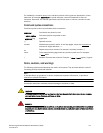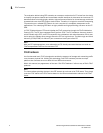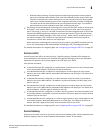Dell Converged Enhanced Ethernet Administrator’s Guide 5
53-1002116-01
Layer 2 Ethernet overview
1
Loop-free network environment
The Dell FCoE hardware uses the following protocols to maintain a loop-free network environment:
• 802.1D Spanning Tree Protocol (STP)—STP is required to create a loop-free topology in the LAN.
• Rapid Spanning Tree Protocol (RSTP)—RSTP evolved from the 802.1D STP standard. RSTP
provides for a faster spanning tree convergence after a topology change.
• Multiple Spanning Tree Protocol (MSTP)—MSTP defines an extension to RSTP to further develop
the usefulness of VLANs. With per-VLAN MSTP, you can configure a separate spanning tree for
each VLAN group. The protocol automatically blocks the links that are redundant in each
spanning tree.
Using MSTP, you can create multiple loop-free active topologies on a single physical topology.
These loop-free topologies are mapped to a set of configurable VLANs. This enables you to
better utilize the physical resources present in the network and achieve better load balancing
of VLAN traffic.
For detailed information on configuring these protocols, see “Configuring STP, RSTP, and MSTP
using the CEE CLI” on page 43.
Frame classification (incoming)
The Dell FCoE hardware is capable of classifying incoming Ethernet frames based on the following
criteria:
• Port number
• Protocol
• MAC address
The classified frames can be tagged with a VLAN ID or with 802.1p Ethernet priority. The 802.1p
Ethernet priority tagging is done using the Layer 2 Class of Service (CoS). The 802.1p Ethernet
priority is used to tag frames in a VLAN with a Layer 2 CoS to prioritize traffic in the VLAN. The Dell
FCoE hardware also accepts frames that have been tagged by an external device.
Frame classification options are as follows:
• VLAN ID and Layer 2 CoS by physical port number—With this option, the port is set to classify
incoming frames to a preset VLAN ID and the Layer 2 CoS by the physical port number on the
Dell FCoE hardware.
• VLAN ID and Layer 2 CoS by LAG virtual port number—With this option, the port is set to classify
incoming frames to a preset VLAN ID and Layer 2 CoS by the Link Aggregation Group (LAG)
virtual port number.
• Layer 2 CoS mutation—With this option, the port is set to change the Layer 2 CoS setting by
enabling the QoS mutation feature.
• Layer 2 CoS trust—With this option, the port is set to accept the Layer 2 CoS of incoming
frames by enabling the QoS trust feature.
For detailed information on configuring QoS, see “Configuring QoS using the CEE CLI” on page 93.


















